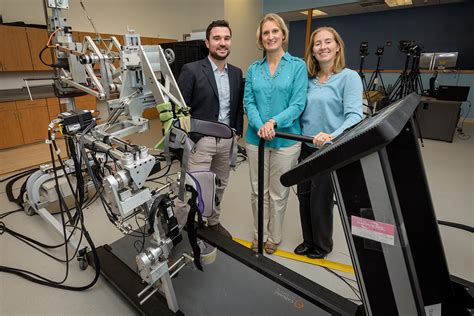Biomechanical engineering is a fascinating and rapidly evolving field that combines principles of mechanics and biology to improve human health and performance. In this blog post, we will delve into the diverse and impactful role of biomechanical engineers in various aspects of our lives. From designing and developing prosthetics to applying biomechanics to sports performance, and from improving human mobility to developing exoskeleton technology for rehabilitation, the scope of biomechanical engineering is wide-reaching and transformative. We will also explore the advances in materials for biomechanical engineering, as well as the integration of biomechanics in robotics and automation. Furthermore, we will discuss the impact of biomechanical engineering on prosthetic limbs and speculate on the future of this exciting field. Join us as we uncover the potential and possibilities of the human machine through the lens of biomechanical engineering.
Table of Contents
Introduction to biomechanical engineering
Biomechanical engineering is a fascinating and rapidly growing field that combines principles of engineering with the study of the human body and its movement. Biomechanical engineers use their knowledge of mechanics, anatomy, and physiology to design and develop technologies that can improve human health, mobility, and performance. By understanding the biomechanics of the body, these engineers can create innovative solutions in areas such as healthcare, sports performance, and rehabilitation.
One of the key objectives of biomechanical engineering is to analyze and understand how the human body moves and interacts with the environment. This involves studying the forces, stresses, and strains that occur within the body during activities such as walking, running, and jumping. Through the use of advanced materials and technologies, biomechanical engineers can then develop devices and systems that can enhance human movement and function, and also assist individuals with disabilities.
Advances in biomechanical engineering have also led to the development of prosthetic limbs that are more functional and comfortable for users. By applying principles of biomechanics and utilizing new materials and manufacturing techniques, engineers have been able to create prosthetics that closely mimic the movement and feel of natural limbs, greatly improving the quality of life for amputees.
As the field of biomechanical engineering continues to evolve, it holds the promise of even more exciting developments in areas such as robotics, exoskeleton technology, and human augmentation. By incorporating principles of biology, mechanics, and engineering, biomechanical engineers are at the forefront of creating transformative technologies that have the potential to revolutionize healthcare, sports, and human capabilities.
The role of biomechanical engineers in healthcare
Biomechanical engineers play a crucial role in improving the healthcare industry through their expertise in applying mechanical principles to biological systems. By utilizing their knowledge of biomechanics, these engineers can contribute to the development of innovative medical devices, equipment, and technologies that can revolutionize patient care and treatment.
One of the key responsibilities of biomechanical engineers in healthcare is to design and develop medical implants that can enhance the quality of life for patients. This can include creating artificial joints, bone implants, and other implants that are biomechanically engineered to mimic the functions of natural biological structures. These implants are designed to improve mobility and functionality for individuals who have suffered from injuries, diseases, or degenerative conditions.
In addition, biomechanical engineers also play a vital role in the design and development of medical devices such as prosthetics, orthotic braces, and assistive technologies. These devices are tailored to meet the specific needs of patients, helping them regain independence and mobility. By leveraging their expertise in biomechanics, engineers can create advanced prosthetic limbs and orthotic devices that offer comfort, stability, and natural movement, providing patients with a better quality of life.
Furthermore, biomechanical engineers collaborate with healthcare professionals to conduct biomechanical assessments and analyses to evaluate movement patterns, muscle function, and gait mechanics. This information is then used to develop customized treatment plans, rehabilitation programs, and assistive technologies that can help patients recover from injuries or surgeries, as well as manage chronic conditions.
Designing and developing prosthetics
When it comes to designing and developing prosthetics, biomechanical engineers play a crucial role in creating innovative and functional solutions for individuals with limb loss or limb difference. These engineers combine their knowledge of biology, mechanics, and materials to design prosthetic devices that closely replicate the function of natural limbs, allowing users to regain mobility and independence.
Advances in technology have paved the way for more personalized and advanced prosthetics, with engineers focusing on creating prosthetic limbs that are not only highly functional but also comfortable and aesthetically pleasing. By leveraging cutting-edge materials and manufacturing processes, biomechanical engineers are able to develop prosthetics that are both lightweight and durable, providing users with a better quality of life.
In addition to designing prosthetics for everyday use, biomechanical engineers are also involved in creating specialized prosthetic devices for athletes, allowing them to compete at the highest levels. By analyzing the biomechanics of various sports and understanding the specific needs of athletes, engineers are able to develop prosthetic limbs that enhance performance and minimize the risk of injury, showcasing the diverse applications of biomechanical engineering.
Overall, the field of biomechanical engineering continues to drive innovation in the design and development of prosthetics, with a focus on improving functionality, comfort, and performance. Through ongoing research and collaboration with healthcare professionals and end-users, engineers are able to create prosthetic solutions that not only meet the physical needs of individuals but also enhance their overall well-being and quality of life.
Advances in materials for biomechanical engineering
Biomechanical engineering has made significant strides in recent years, particularly in the development of advanced materials that enhance the field’s capabilities. These materials play a crucial role in creating innovative solutions for a wide range of healthcare, sports, and rehabilitation applications.
One of the significant advancements is the development of biocompatible materials that can be safely integrated into the human body. These materials are essential for the design and production of biomechanical devices such as implants, prosthetics, and assistive devices, ensuring that they are not only functional but also compatible with the body’s biological systems.
Researchers and engineers in the field have also been experimenting with smart materials that can respond to external stimuli, such as temperature changes or mechanical stress. This has led to the development of advanced prosthetics and exoskeletons that can adapt to the user’s movements and provide enhanced support and functionality.
Furthermore, advances in nanomaterials have opened up new possibilities for biomechanical engineering, allowing for the creation of lightweight yet durable components for various applications. These nanomaterials have the potential to revolutionize the design of prosthetics, implants, and other biomechanical devices, making them more comfortable, efficient, and long-lasting.
Applying biomechanics to sports performance
Implementing biomechanics in the field of sports has revolutionized the way athletes train and perform. By using biomechanical engineering principles, coaches and trainers are able to analyze and optimize the movements and techniques of athletes, leading to improved performance and reduced risk of injury.
One of the key aspects of applying biomechanics to sports performance is the use of motion capture technology. This allows for the precise measurement and analysis of an athlete’s movements, providing valuable insights into their technique and efficiency. By identifying areas for improvement, athletes can make targeted adjustments to their training and performance, ultimately leading to better results.
Furthermore, biomechanical engineering has also contributed to the development of specialized sports equipment and apparel. For example, the design and construction of running shoes have been heavily influenced by biomechanical research, with the aim of enhancing performance and reducing the risk of injury. Similarly, the design of sports equipment such as tennis rackets, golf clubs, and even swimsuits has been optimized using biomechanical principles.
Overall, the application of biomechanics to sports performance has had a significant impact on the way athletes train, compete, and recover. By leveraging the insights and innovations provided by biomechanical engineering, athletes are able to push the boundaries of their capabilities and achieve new heights in their respective sports.
Improving human mobility through biomechanical engineering
Biomechanical engineering plays a crucial role in improving human mobility by developing innovative prosthetics and orthotics. The advancements in materials and technology have enabled engineers to design and fabricate prosthetic limbs that closely mimic the function of natural limbs, providing individuals with mobility and independence. By understanding the principles of biomechanics, engineers can create prosthetics tailored to the specific needs of each individual, enhancing their quality of life.
Furthermore, biomechanical engineers are also involved in the development of assistive devices such as wheelchairs, walkers, and braces, which aid individuals with mobility impairments to navigate their environment with greater ease. These devices are designed with ergonomics and user comfort in mind, ensuring that they are effective and user-friendly. Additionally, the integration of smart technologies such as sensors and actuators has further improved the functionality of these devices, allowing for greater customization and adaptability to the user’s needs.
Moreover, biomechanical engineering has contributed to the advancement of rehabilitation techniques, such as the development of exoskeleton technology. These wearable robotic devices are designed to assist individuals with movement impairments in regaining mobility and strength. By applying principles of biomechanics, engineers can create exoskeletons that provide the necessary support and assistance to individuals undergoing rehabilitation, ultimately improving their mobility and restoring functional movement.
Overall, the field of biomechanical engineering continues to make significant strides in improving human mobility through the design of innovative prosthetics, assistive devices, and rehabilitation technologies. With ongoing research and development, the future holds great promise for further advancements in this field, ultimately enhancing the lives of individuals with mobility impairments.
Developing exoskeleton technology for rehabilitation
Biomechanical engineers play a crucial role in developing exoskeleton technology for rehabilitation, which has the potential to significantly improve the lives of individuals with mobility impairments. These engineers integrate their knowledge of biomechanics, robotics, and materials science to design and create exoskeletons that can assist individuals in regaining mobility and independence.
Advances in materials for biomechanical engineering have further contributed to the development of exoskeleton technology, as engineers are able to create lightweight, yet durable materials that are essential for creating comfortable and effective exoskeletons. These materials also allow for the customization of exoskeletons to fit the specific needs of each individual, enhancing the overall effectiveness of the rehabilitation process.
Applying biomechanics to the design of exoskeleton technology involves a deep understanding of human movement and physiology. By analyzing the biomechanics of walking, engineers can ensure that exoskeletons provide the necessary support and assistance to enable natural and efficient movement. Through the use of advanced sensors and control systems, exoskeletons can adapt to the user’s movements, providing assistance where needed and promoting a more natural walking pattern.
The future of biomechanical engineering holds tremendous promise for the continued development of exoskeleton technology for rehabilitation. With ongoing research and innovation, engineers are working towards creating exoskeletons that are not only effective in aiding mobility, but also intuitive and seamless to use. As technology continues to advance, the potential for exoskeletons to transform the rehabilitation process for individuals with mobility impairments is truly inspiring.
Biomechanics in robotics and automation
Robotic and automation technology has made significant strides in recent years, and biomechanical engineering has played a crucial role in these advancements.
Biomechanics, the study of the mechanical aspects of living organisms, is being applied to robotics and automation to improve the performance and efficiency of these systems.
By understanding the biomechanics of human movement, engineers are able to design robots that can mimic human motion and perform tasks with greater precision and accuracy.
Additionally, biomechanical principles are also being used to develop robots that can assist in physical therapy and rehabilitation, allowing individuals to regain mobility and function.
The impact of biomechanical engineering on prosthetic limbs
Biomechanical engineering has had a profound impact on the development and improvement of prosthetic limbs. Through the application of biomechanics, engineers have been able to design prosthetics that are more functional, comfortable, and better suited to meet the needs of amputees.
One of the key advancements in biomechanical engineering for prosthetic limbs is the use of advanced materials. New materials such as carbon fiber and titanium allow for prosthetics to be lighter, stronger, and more durable, improving the overall performance and longevity of the limb.
Furthermore, biomechanical engineers have been able to utilize robotics and automation in the design and development of prosthetic limbs. This has led to the creation of more natural and responsive prosthetics, allowing amputees to regain a greater level of mobility and independence.
Overall, the impact of biomechanical engineering on prosthetic limbs has been transformative, leading to the development of prosthetics that not only restore function but also improve the quality of life for those in need.
The future of biomechanical engineering
Biomechanical engineering has made significant advancements in recent years, and the future of this field looks promising. One of the key areas of development in the future of biomechanical engineering is the use of advanced materials in the design and development of prosthetics. With continued research and innovation, engineers are constantly finding new and improved materials to create more durable, comfortable, and lifelike prosthetic limbs for amputees.
Another exciting aspect of the future of biomechanical engineering is the development of exoskeleton technology for rehabilitation. This technology has the potential to greatly improve the mobility and quality of life for individuals with mobility impairments. As engineers continue to refine and improve exoskeleton designs, we can expect to see more widespread use of this technology in healthcare settings.
Furthermore, the future of biomechanical engineering holds great promise for advancements in robotics and automation. As technology continues to evolve, biomechanical engineers will play a vital role in the development of robotic devices that can assist with tasks such as surgery, physical therapy, and patient care.
Overall, the future of biomechanical engineering is filled with possibilities for improving healthcare, mobility, and quality of life for individuals around the world. With continued research and innovation, we can expect to see even more groundbreaking advancements in this field in the years to come.





